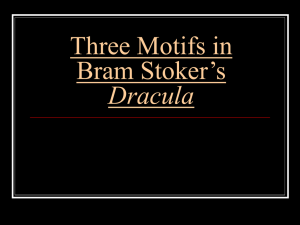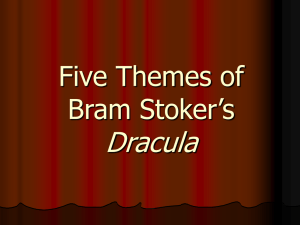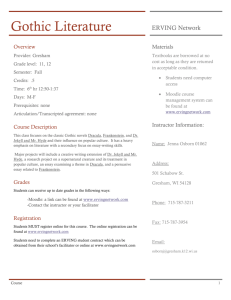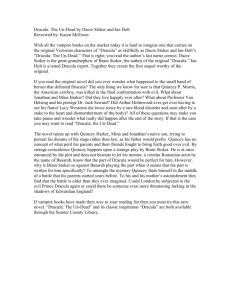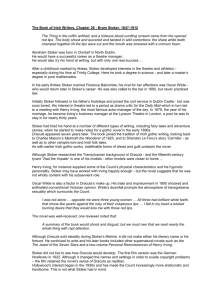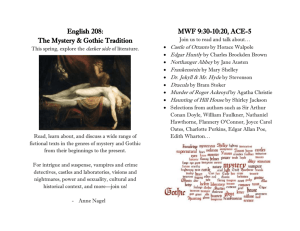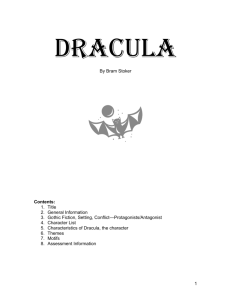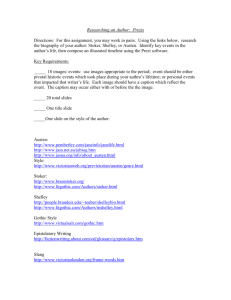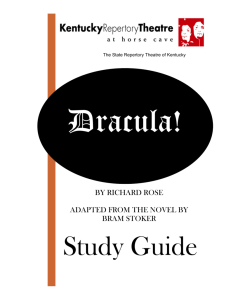Dracula Schema Guide - Ms. Chapman`s Class
advertisement
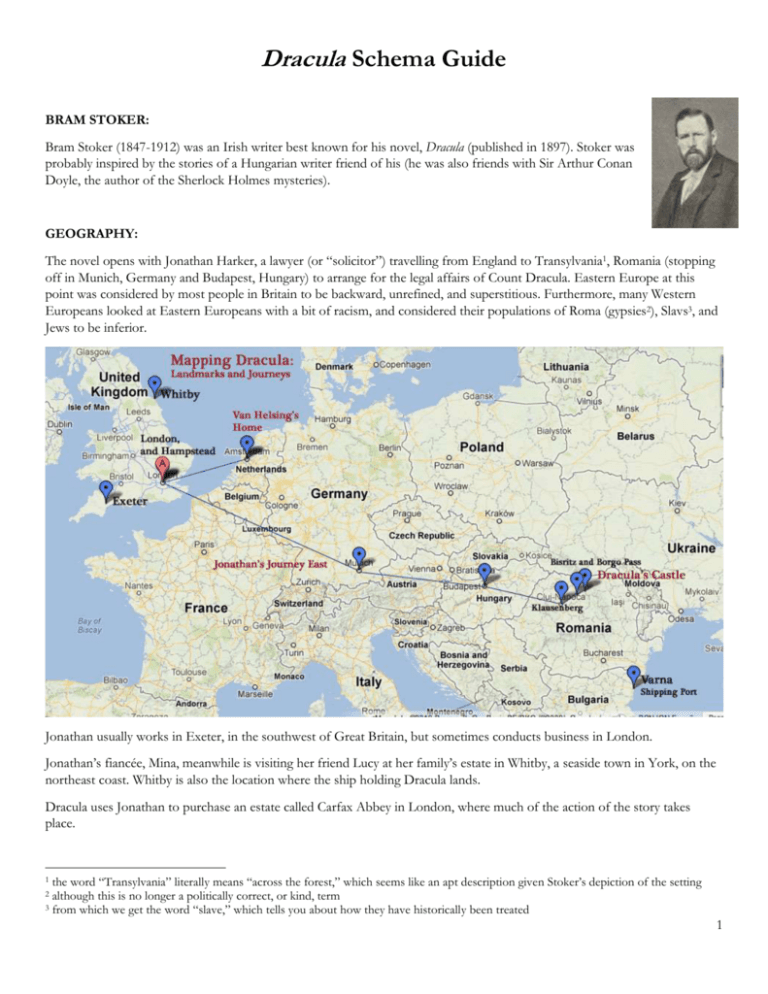
Dracula Schema Guide BRAM STOKER: Bram Stoker (1847-1912) was an Irish writer best known for his novel, Dracula (published in 1897). Stoker was probably inspired by the stories of a Hungarian writer friend of his (he was also friends with Sir Arthur Conan Doyle, the author of the Sherlock Holmes mysteries). GEOGRAPHY: The novel opens with Jonathan Harker, a lawyer (or “solicitor”) travelling from England to Transylvania1, Romania (stopping off in Munich, Germany and Budapest, Hungary) to arrange for the legal affairs of Count Dracula. Eastern Europe at this point was considered by most people in Britain to be backward, unrefined, and superstitious. Furthermore, many Western Europeans looked at Eastern Europeans with a bit of racism, and considered their populations of Roma (gypsies2), Slavs3, and Jews to be inferior. Jonathan usually works in Exeter, in the southwest of Great Britain, but sometimes conducts business in London. Jonathan’s fiancée, Mina, meanwhile is visiting her friend Lucy at her family’s estate in Whitby, a seaside town in York, on the northeast coast. Whitby is also the location where the ship holding Dracula lands. Dracula uses Jonathan to purchase an estate called Carfax Abbey in London, where much of the action of the story takes place. the word “Transylvania” literally means “across the forest,” which seems like an apt description given Stoker’s depiction of the setting although this is no longer a politically correct, or kind, term 3 from which we get the word “slave,” which tells you about how they have historically been treated 1 2 1 Dr. Abraham Van Helsing travels to England from the Netherlands. VICTORIAN SOCIETY Dracula is set during the Victorian era (1837 to 1901; named for British Queen Victoria). Some key elements of this time and place that impact the plot and characters include: 4 The Industrial Revolution and scientific progress – Over the past several hundred years, Europe had made rapid advancements in scientific learning and the practical application of those principles to matters of business and production. Machines were becoming more a part of daily life for many people, making work faster and easier (one of the characters in the novel, Dr. John Seward, records his diary using a phonograph instead of writing it down; telegraphs allowed people to communicate very quickly over a long distance). Britons considered themselves very modern compared to the rest of the world, and considered most other countries to be technologically behind. o They considered British medicine to be cutting-edge – no longer were doctors bleeding their patients or practicing a combination of medicine and spiritualism. Physicians understood basic germ theory and the spread of disease. But not all of the changes in the world of healthcare were necessarily advancements. Physiognomy was the popular practice of determining someone’s personality based on the shape of their face and skull; it was commonly believed that you could figure out who would become a criminal based on measurements of craniums.4 Treatment of the mentally ill was often barbaric – people with mental illnesses were placed in asylums or sanitariums, where patients had little say in their treatment (Dr. Seward from the novel is a doctor in charge of such an institution). A caste-based society – British society at this time was highly stratified. At the top was the aristocracy/royalty, who still possessed enormous land holding and estates that made them wealthy and powerful. Those with titles (such as Arthur, Lord Godalming) were often given more respect and preferential treatment. During the Victorian Era (partially as a result of the Industrial Revolution), the middle class grew rapidly – Jonathan, Mina, and Dr. Seward are all part of this segment of society. Britain still had significant lower classes, however, which were often forced to work long hours in dangerous conditions. Colonization – The Victorian Era was the height of the British Empire, a period of time in which Britain used its military and economic might to bend other countries across the world to its will. As a result, Britain become extremely wealthy, and its capitol city, London, became one of the most glamorous, cosmopolitan centers in the world. But Britain’s involvement in the rest of the world wasn’t limited to the exportation of its goods and culture; many of the colonized countries, after establishing trade with Britain and learning the English language, sent some of their people back to the mother country. Many British people felt like immigrants from other countries were corrupting British culture by introducing new religions, styles of dress, cuisines, customs, etc. They also worried that people from other lands might bring new diseases to the island. Manners and morals concerning women – Upper and middle class women during the Victorian Era were supposed to be polite, private, chaste, religious, motherly, and selfless. A lady was expected to confine her role to the domestic sphere (running a house and raising children) and trust her husband to make decisions for her. Men of this era often idealized women as perfect, angelic creatures who needed their protection from the corrupting influences of the outside world. Obviously, this is complete and utter nonsense. 2 ELEMENTS OF CHRISTIAN THEOLOGY All of the characters on the British side in Dracula are Christian, and the plot of the novel heavily relies on the notion of Christianity as a force against evil. Some elements of Christianity that appear in the book include: The duality of the physical versus the spiritual (or the body versus the soul) Salvation/Heaven – Jesus Christ died for the sins of humankind, and therefore the souls of Christians will go to a kind of paradise after death Communion – the taking of bread and wine as symbols of eating Christ’s body and drinking his blood (the Dracula story perverts this element when Dracula literally drinks the blood of his victims) o The wafer that is eaten in Communion is called the Host. Crucifixes – symbols of the cross on which Christ died Water – water is thought to be a purifying force (it is used in baptisms to wash away sins); Dracula can only cross water at certain times, and holy water is especially threatening to him Wild roses – the five-petaled wild rose is a symbol of the five wounds that Christ bore during his crucifixion POSSIBLE HISTORICAL ORIGINS OF DRACULA By some accounts, Bram Stoker was inspired by a real historical figure named Vlad Tepes, otherwise known as “Vlad the Impaler.” Vlad was a 15th century Romanian ruler who defended his lands from incursions from the Turkish Ottoman Empire. He often tortured his victims in creative and horrific ways as a warning to others. Vlad’s father’s nickname was “Dracul” (“dragon”), so Vlad took on the nickname “Dracula” (“son of the dragon”). Elizabeth (Erzebet) Bathory, a Hungarian countess who lived approximately 100 years later than Vlad, is another possible source of inspiration. The legend goes that Countess Bathory was beating one of her serving girls when some of the girl’s blood splashed on her skin. When she wiped the blood off, the Countess thought that her skin looked younger and prettier, which gave her the notion that bathing in the blood of young girls would preserve her youth. Countess Bathory would abduct girls from the villages she ruled and kill them for their blood. She became the most prolific serial killer of all time. Eventually Bathory began taking the daughters of aristocrats, which caused outrage; she was put on trial and sentenced to be walled up in her castle. And finally, popular vampire mythology holds that vampires are repelled by garlic (a tradition that Stoker upholds in Dracula). The root of this may be that the consumption of garlic makes a person’s blood unappealing to mosquitos! THE GOTHIC NOVEL Dracula follows a literary tradition called the “gothic” genre. Other gothic fiction includes Mary Shelley’s Frankenstein, the poems and stories of Edgar Allen Poe, Robert Louis Stevenson’s Dr. Jekyll and Mr. Hyde, Emily Brontë’s Wuthering Heights, Oscar Wilde’s The Picture of Dorian Grey, and Gaston Leroux’s The Phantom of the Opera, among others. Gothic fiction often reflects on the darkness of the human soul. Its subject matter may be horrifying, and it can include elements of the supernatural. Characters in gothic fiction are often burdened by history, which may be manifested through the inclusion of crumbling, onegreat buildings. American writers took the European gothic tradition and applied it to a new American setting, called “American Gothic.” (And within that subgenre is “Southern Gothic.”) 3 FOREIGN EXPRESSIONS “Omnia Romae venalia sunt.” (Latin) – “Everything in Rome is for sale.” apropos (Latin) – with reference to; appropriate for a certain situation quondam (Latin) – the former chapelle ardente (French) – “burning chapel,” or the chapel where a corpse is kept “Mein Gott!” (German) – “My God!” pourparlers (French) – negotiations to reach a treaty non causa (Latin) – does not cause ignoratio elenchi (Latin) – an irrelevant conclusion “In manus tuas, Domine!” (Latin) – “In your hands, God!” “Festine lente.” (Latin) – Make haste slowly. “Nota bene.” (Latin) – note well; take note double entente (French; also sometimes “double entendre”) – an ambiguous meaning; can be interpreted two ways “Omne ignotum pro magnifico.” (Latin) – “Everything unknown seems grand,” or “Everything unknown seems difficult.” 4
